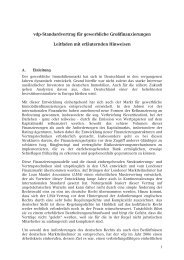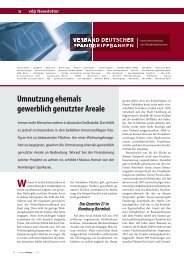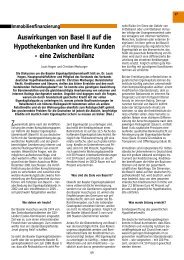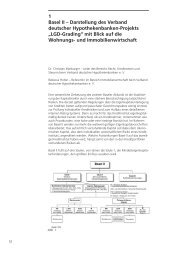The Pfandbrief 2011 | 2012
The Pfandbrief 2011 | 2012
The Pfandbrief 2011 | 2012
Create successful ePaper yourself
Turn your PDF publications into a flip-book with our unique Google optimized e-Paper software.
<strong>The</strong> Legal Framework for Issuing <strong>Pfandbrief</strong>e<br />
A number of alternatives are available to the cover pool administrator to ensure that the<br />
<strong>Pfandbrief</strong> creditors’ claims are satisfied in a timely fashion:<br />
18<br />
He can take the payment flows of the cover pools and service the outstanding liabilities<br />
in accordance with the terms of issue. In particular, he may sell individual assets in order<br />
to procure liquidity and use a funding register for this purpose. This form of settlement<br />
would be continued until all the <strong>Pfandbrief</strong>e were repaid. Any surplus would be passed to<br />
the insolvency administrator.<br />
As a result of the 2009 amendment, § 30 par. 2 sent. 5, 2nd half-sentence <strong>Pfandbrief</strong> Act<br />
explicitly states that he may take up a refinancing loan in order to procure liquidity.<br />
In the explanatory memorandum to the 2010 amendment (Bundesrat printed paper 155/10<br />
of March 26, 2010, p. 77) clearly states that the general clause-like description of the<br />
cover pool administrator’s powers and competences also include the issuance of bonds. In<br />
the absence of provisions governing rank, such bonds would rank equal with <strong>Pfandbrief</strong>e<br />
issued prior to the nomination of the cover pool administrator, meaning they would constitute<br />
covered bonds of <strong>Pfandbrief</strong> quality. Thus, the new provision set forth in § 2 par. 4<br />
<strong>Pfandbrief</strong> Act provides the basis on which the cover pool administrator could issue such<br />
bonds under the name “<strong>Pfandbrief</strong>”.<br />
Following the 2009 amendment, § 31 par. 8 <strong>Pfandbrief</strong> Act explicitly states that the cover<br />
pool administrator is entitled to make use of the <strong>Pfandbrief</strong> Bank’s staff and materials, and<br />
that he must refund to the insolvent estate only the costs actually incurred in this respect.<br />
<strong>The</strong> cover pool administrator has access to all payments that are made in respect of the<br />
cover assets; the insolvency administrator must ensure such access by cooperating with<br />
the cover pool administrator (see also § 31 par. 7 <strong>Pfandbrief</strong> Act). This also applies to<br />
amounts or partial amounts which pertain to parts of loans included in cover which are<br />
not eligible as cover for <strong>Pfandbrief</strong>e. <strong>The</strong> cover pool administrator must hand over such<br />
amounts to the insolvency administrator when called upon to do so (§ 30 par. 3 sent. 3<br />
<strong>Pfandbrief</strong> Act).<br />
He may transfer all or parts of the cover assets in one cover pool and liabilities under the<br />
<strong>Pfandbrief</strong>e, together, to another <strong>Pfandbrief</strong> Bank, subject to approval by the supervisory<br />
authority (BaFin). In this context, he may agree with another <strong>Pfandbrief</strong> Bank that he will<br />
hold the cover pools on a fiduciary basis for that <strong>Pfandbrief</strong> Bank. Transferring the cover<br />
pools in this way rules out the need for complex and time-consuming individual transfers.<br />
Rating agencies often raise the question of the “insolvency remoteness of the voluntary<br />
overcollateralization”. A frequent consequence of the stress tests they apply for the timely<br />
servicing of <strong>Pfandbrief</strong>e is that a <strong>Pfandbrief</strong> Bank must maintain overcollateralization<br />
exceeding the legally required 2 %. In this connection, to question the insolvency remoteness<br />
of this “excess cover” is to ignore the fact that, within the scope of these stress tests,<br />
such excess cover would automatically be part of the legally required cover. If a rating<br />
agency does not believe that the cover assets are absolutely sound and therefore calculates<br />
what overcollateralization is required, then logically these assets that constitute overcollateralization<br />
are not (from the rating agency’s viewpoint) “voluntary overcollateralization” at
















